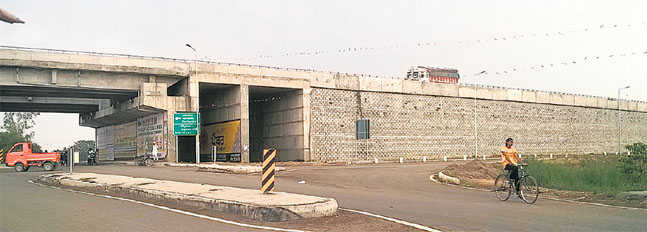When do you care to remember what a highway is named? When the journey is awful, and when it is awesome. The 105-km Pathankot-Amritsar National Highway (NH-15) scored high on the first count, and is now doing so on the second. This crucial highway exemplified all that was wrong with road travel till November last year. The journey of four hours between the two cities now takes an hour-and-a-half.
Three years ago, the National Highways Authority of India (NHAI) — petitioned by residents, the business community and bus operators — started work on NH-15 after a cumbersome land acquisition process. Surveys undertaken by various agencies had concluded how the economies of Pathankot, Dinanagar, Gurdaspur, Batala and Amritsar were seeing a downward spiral because of the lack of quality road infrastructure. A redone NH-15 was one solution.
A dozen flyovers and bypasses skipping five railway crossings have changed the dynamics of travel and business. For good and bad too.
A regular visitor to Amritsar’s Guru Nanak Dev University, Dr Nirmal Pandhi, principal of Shanti Devi Arya Mahila College at Dinanagar, 10 km from Gurdaspur, has to travel at least thrice a week. She recalls how she used to loathe the idea: “My driver would take three hours to reach Amritsar after negotiating heavy and unregulated traffic. There were four railway crossings on the way. Now, there’s not even one. I am in Amritsar in 70 minutes flat.” Dr KC Manchanda of Chintpurni Medical College and Hospital, Pathankot, too had to endure a journey of four hours to Amritsar daily. Life, for him, has completely changed.
“Flyovers have an added benefit of minimising the acquisition of land,” says Pathankot resident Pushp Lata, mother of Ashok Chakra awardee Lt Triveni Singh, who regularly travels to Gurdaspur and adjoining cities to attend functions honouring martyrs.
Now, for the downside. Romesh Mahajan, who heads the Gurdaspur District Hotel Association, though happy with how NH-15 has changed lives is worried about the negative impact on the micro-economy of the small towns located on the way. “While acting as a catalyst for the development of the region, the highway has disturbed the economy of small towns. A majority of hotels and dhabas, which used to see a massive influx of tourists, are virtually on the verge of closure. Many have downed shutters. Several petrol pumps on the Pathankot-Amritsar stretch are recording just 50 per cent sales since not many commuters stop. Small-time vegetable and fruit sellers have disappeared from the scene,” he says.
Batala-based hotelier Gurpreet Singh Raju, who had a roaring business till the bypasses became operational, says all tourist traffic from the neighbouring states used to pass through Batala before moving on to Amritsar and the Wagah border. “I agree that the bypasses were the need of the hour, but then somebody should listen to us too. NH-15 has led to our doom,” he says. Doom or boom, NH-15 is not easy to forget.
More accident-prone now
A PWD official points to the lack of provisions to ensure that accidents do not occur where traffic enters the cities from NH-15. “No provision has been made for vehicle under-passes in front of the Beant College of Engineering and Technology, Institute of Hotel Management, Nutrition and Catering, Paniyar sugar mill and the Gurdaspur polytechnic. All these places have become highly accident-prone because of lack of planning on the part of NHAI.”
Road dividers ‘breached’ all over
A conservative estimate puts at 70 the number of road dividers that have been “punctured” or “breached” by petrol pump owners and hotel and dhaba owners. There has been a manifold increase in the number of accidents. Villagers instead of taking a U-turn tear away a part of the divider to take a short-cut. Owners of commercial establishments have also breached these dividers just to ensure that their clients are not inconvenienced. “They are the biggest villains,” says a police officer. However, not a single FIR has been lodged.
High toll tax taking a toll
There are two toll tax plazas on the highway, with high rates. The distance between Gurdaspur and Pathankot is 34 km and the fuel cost for to-and-fro car travel comes to Rs 130 on an average. Add to it the toll tax (to and fro) of an equal amount, and a person who travels to Pathankot from Gurdaspur and returns soon after has to cough up a minimum of Rs 260. “This has come as a rude shock. Travel has become unaffordable,” says a regular commuter.
No railway line electrification
Over the years, a powerful lobby of private bus operators has been in the forefront of stalling electrification of the Amritsar-Pathankot railway line. However, experts say no study has been conducted on how and to what extent it will impinge on the existing road network. “Irrespective of whether any such rail system comes into being, it will not be a substitute for the development of the urban road network, since the vehicle population is bound to grow anyway,” says a top rail officer.
700 light points along the stretch, 2,000 needed
Norms say there should be one light point after every 50 metres of the national highway, which, in effect, means that there should have been 2,000 such light points on the 105-km stretch of the highway. However, just 700 are in place.
Unlock Exclusive Insights with The Tribune Premium
Take your experience further with Premium access.
Thought-provoking Opinions, Expert Analysis, In-depth Insights and other Member Only Benefits
Already a Member? Sign In Now










